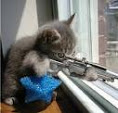In the late 1960s, the Navy and the Marine Corps were facing up to the reality that the techniques for moving troops and heavy cargo ashore for amphibious assaults had not radically changed since World War II. The LCM-8s, designed during the Vietnam War, were faster and heavier than the Higgins Boats, but in concept, they were the same as the WW2 LCMs and LCUs.
The Naval Sea Systems Command began three design projects. The NAVSEA project manager was Jim Schuler. The designs were named after his sons, Jim, Joe and Jeff. The Joe boat would carry about 120 tons of cargo ashore, the Jeff boat would carry sixty tons and the Jim boat would carry thirty tons. The numbers for the two larger boats were derived from the weight of a M-60 tank-- the Joe boat could ferry two ashore, the Jeff boat, one. Only the Jeff boat got to the part of cutting metal. Two prototypes were ordered and tested, the Jeff-A was built by Aerojet General and the Jeff-B, built by Bell Aerospace. Soon into the project, the names were written in all-caps, possibly so everyone would forget that the boats were named after children. The JEFF-A had four steerable jet nozzles. The JEFF-B had two steerable nozzles forward and two ducted fans with rudders (sort of like an airboat on steroids) aft. This is a crappy photo of the two flying in formation. I didn't want to chance taking it out of its frame:
To say that both contractors had problems with their boats would be an understatement. But for the most part, it was understood at the time that the JEFF boats were a significant step and, by the late `70s, they were both running. A hangar and a beaching ramp were built at the Panama City, FL naval station. The JEFF boats were based there and did extensive testing.
The project engineers largely thought that the JEFF-A was the better of the two boats. The Navy disagreed. The JEFF-B's progeny were designated the LCAC (Landing Craft Air Cushion). The award was given to Textron (corporate parent of Bell) in 1984. Over 90 LCACs were built.
I don't know what happened to the JEFF-A. Supposedly, it went to Alaska for tests in Prudhoe Bay after the Navy chose the winning boat. But after that, I heard nothing about it.
The LCAC is beginning to reach the end of its service life. Last I heard, the Navy will just buy more of them.
Cross Country
1 hour ago


1 comment:
The new ship to shore connector (SSC) isn't quite a line restart but it's close. They're getting a glass cockpit, engine upgrades, more aluminum and composites for corrosion control and some lessons learned stuff. The did compete them out but Textron ended up winning the award and they'll be building them here in Louisiana as far as the metal portion goes I believe.
Post a Comment